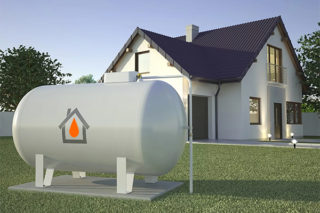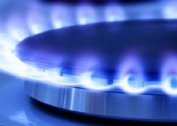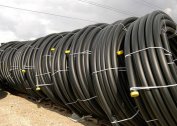Gasification is a good way to reduce the cost of electricity and heating a residential building. In the absence of a central gas pipeline, modern gas tanks for a country house can solve the problem. Before choosing a suitable device, you will need to study its operational characteristics, determine the type of device and calculate the optimal gas flow.
What are gas holders
The gas holder is a capacious metal container in which household gas is pumped, designed for stoves and heating systems. Tanks are made of stainless steel with a wall thickness of at least 5.5 mm and treated with special substances to prevent corrosion. Cylinders are also supplemented with sensors that detect the amount of gas inside and show the pressure level.
Gas tanks make it possible not to connect to centralized systems and always have a large supply of gas. They are placed outside the buildings at a certain distance, fuel enters the house along special highways and is consumed during the operation of the devices. In most cases, balloons are buried in the ground so that they do not occupy excess space on the site.
For private homes, the best choice would be a gas tank with a volume of up to five cubic meters. This amount is enough to heat a residential building with an area of 150 sq.m.
Operational characteristics
The main characteristics of cylinders for heating and other purposes include wall thickness, temperature during operation, gas tank volume and pressure. The walls of the containers can not be thicker than 10 mm, while too thin are not designed for storage of domestic gas mixtures. Cylinders for Russian regions can store liquefied propane and butane, which do not need additional processing, which increases the requirements for the reliability of the design.
The temperature also depends on the specific area, in most cases the cases are supplemented with frost-resistant coatings that can withstand up to -40 degrees. Volume and pressure indicators are completely interconnected, therefore it is better to choose reservoirs with a correction of up to 16 atm and capacity in the range of 2000-5000 liters for a home. The calculation of the gas tank for a private house depends on how much fuel is required in each individual case.
Varieties of gas holders
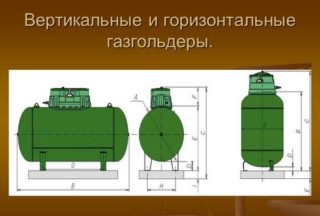 A large number of options for available gas holders are presented on the market, they are divided into two types according to the method of installation and bedding.
A large number of options for available gas holders are presented on the market, they are divided into two types according to the method of installation and bedding.
By type of construction
Capacities can be installed horizontally or vertically depending on the features of the housing. The options of the second type take up less space, while they have increased security requirements. If there is a high level of groundwater in the area, it is better to give preference to horizontal cylinders. In this case, you will not need to dig deep pits, which will reduce the risk of flooding to a minimum. But keep in mind that such a gas holder will need a large area.
By type of occurrence
Choosing a gas holder and calculating the gas flow rate, pay attention to the type of reservoir. It is applicable only to horizontal cylinders that can be completely submerged in the ground or mounted on its surface. Ground-based options are much more convenient, since they do not have to be excavated once a year in order to check for compliance with physical and technical parameters.
Factors Affecting Gas Consumption
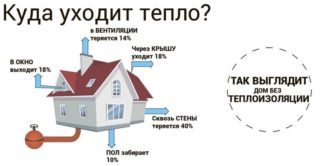 The gas flow rate in the tank is usually influenced by several factors:
The gas flow rate in the tank is usually influenced by several factors:
- wind rose and climate;
- area of a residential building, the level of insulation of doors and windows, materials of walls, roofs, foundations;
- the number of residents and the mode of their stay in the house;
- technical characteristics of the boiler for heating, the use of additional appliances;
- number of heating radiators.
In order for the boilers to function normally, the gas pressure inside the pipeline must not drop below 35 mbar. This norm is not always maintained in main gas pipelines, where it ranges from 8-22 mbar.
To determine how much is enough for a home gas tank and one gas station, you can use a gas meter. To obtain more accurate indicators, special mathematical calculations are carried out to help estimate fuel consumption and minimize all costs for it.
The choice of gas tank volume for a country house
When calculating the gas tank for a country house or cottage, it can be determined that cylinders of 2700 and 4850 liters are suitable for such buildings. When choosing a typical tank size, several factors are considered. If tenants are in the house constantly, you need to refuel the tank at least twice a year due to the difference in the concentrations of butane and propane in mixtures for the summer and winter periods. All gas holders are filled with liquefied gas by 85%, leaving free space for hydrocarbon passing into the evaporation phase.
Calculation of gas consumption per year from a gas tank
 Calculate gas consumption per year and per month using the formula V = Q / (q x n)where:
Calculate gas consumption per year and per month using the formula V = Q / (q x n)where:
- V - volume of LPG;
- Q - heat loss;
- q - the minimum specific value of the calorific value of fuel;
- n - Efficiency of the general gas supply system.
To obtain reliable data, you need to know the efficiency of the heating boiler and carry out the calculation, expressing the volume of propane and butane in liters. On average, the daily gas consumption will be 978 liters, for a year this amount will not exceed 3488 liters.
Gas consumption per 100 m2
To determine fuel consumption taking into account the size of the room, first of all, it is necessary to find out the average cost of gas. After that, the area value is divided by 10, if it is about 100 m2. This condition is taken into account when choosing a gas holder and counting on how much one refueling is enough.
You can reduce gas costs by following the standard recommendations for insulation of walls, roofs, basements and attics. It is important to change the old window blocks in a timely manner, double-glazed windows with a special non-freezing profile will become the best option. The parameters of the boiler are adjusted according to needs. Condensation-type devices have a higher efficiency, especially if they are built into the collector heating system. The installation of controllers for automating the supply of heat and temperature regulators for batteries also helps to save money.
